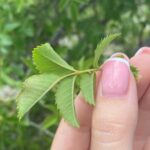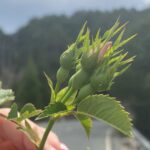Αρκοτριανταφυλλιά, Τριανταφυλλιά η κορυμβοφέρουσα
Etymology of Rosa corymbifera: The Latin name of the genus "Rosa" has uncertain origins: some authors derivate it from the Ancient Greek "ρόδον" [rodon], which among others means "rose flower, vagina", but the word itself is a loan and originates from another language/dialect, presumably from Persia. "Corymbifera" is Ancient Greek, from "κόρυμβος + φέρω" [corymvos + fero], which means "corymb + bear" (to bear corymbs). A corymb is a raceme in which the pedicels of the lower flowers are longer than those of the upper ones so that the appearance of the inflorescence overall is that of a flat flower. The lower flowers open first, and the axis of a corymb continues to produce flowers (indeterminate growth).
At least three Rosa kinds (two species and another subspecies) have been identified so far in the wild Cypriot habitat.
It is an indigenous but non-endemic plant in Cyprus. The species, in Cyprus, is encountered at an altitude of 600–1950 (mount Olympus) metres in the Troodos Mountains range as well as in the surrounding mountains; a good place to see this species in the wild is the area around Mount Olympus. Rosa corymbifera, as Rosa canina, can be seen either with pink-white/pink or white flowers. Its flowering period is between May and June.
How to identify Rosa corymbifera:
- Rosa corymbifera's pedicels are glabrous or very sparsely setose (opposite for Rosa micrantha subsp. chionistrae)
- Rosa corymbifera's leaflets are inodorus (opposite for Rosa micrantha subsp. chionistrae) , and they are pubescent on the undersurface, at least along the midrib and nerves (Rosa canina's leaflets are glabrous or almost glabrous on both sides)
- Rosa corymbifera's sepals are not conspicuously glandular externally (opposite for Rosa micrantha subsp. chionistrae)
- Rosa corymbifera's petals can be pink or white - the same with canina
- Rosa canina's styles are distinctly pilose; Rosa corymbifera's are glabrous or thinly pilose (a style is a structure found within the flower. It's the part that connects the stigma and the ovary or a rose flower)


